osu!taiko
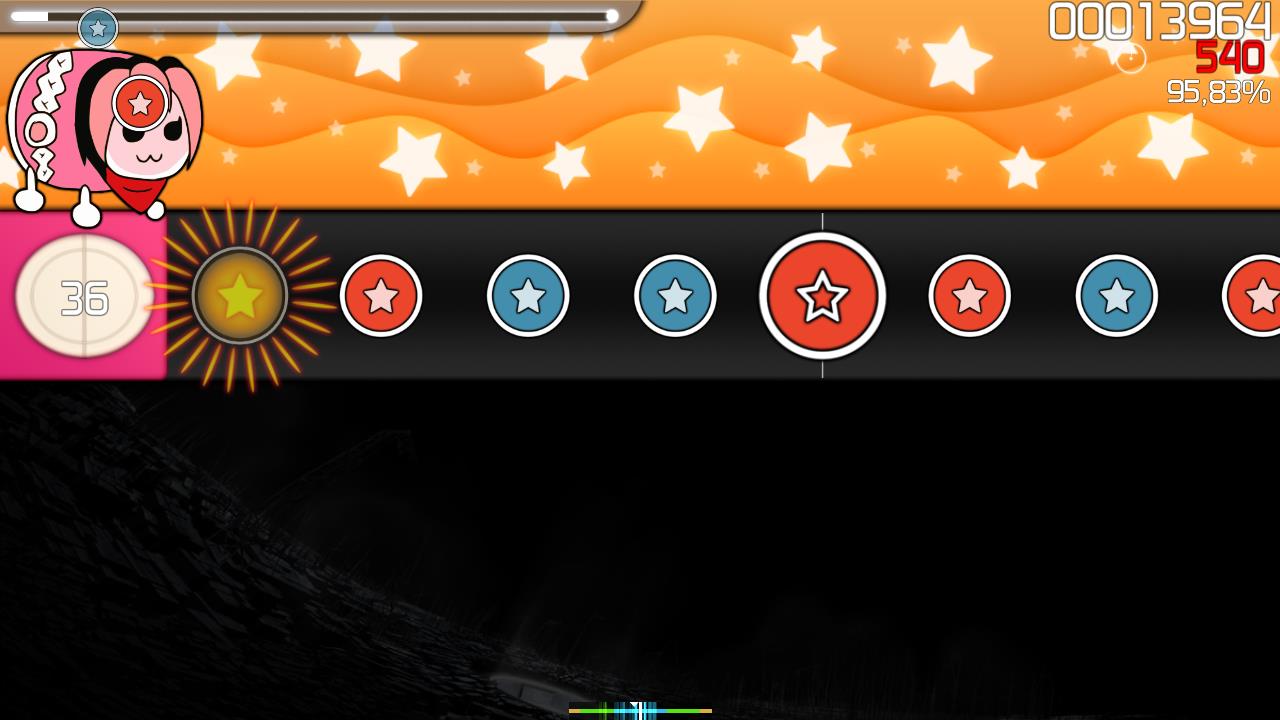 osu!taiko Interface
osu!taiko Interface
osu!taiko is a game mode in osu! based on the Japanese rhythm game series, Taiko no Tatsujin (released as Taiko: Drum Master in North America).
 Gameplay
Gameplay
Song Selection
To access the osu!taiko game mode, press Ctrl + 2 at the same time.
Alternatively, click on the Mode button and select osu!taiko.
Gameplay Basics
Playfield
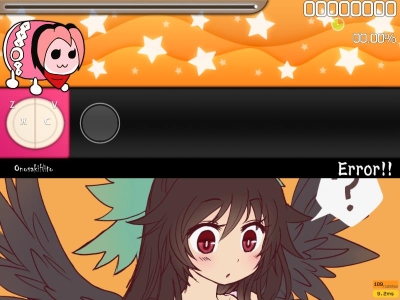 osu!taiko playfield
osu!taiko playfield
For players with prior Taiko no Tatsujin experience:
- No chibi dancers at the bottom (must be storyboarded)
- The health bar must be at least 50% full to pass the song
- Kiai Time triggers the "Go-Go Time"
- Gameplay gimmicks like the hit balloons or forked paths are not implemented (only the basics)
- Background difference
- A video or static background image-only beatmap will take up the lower portion of the screen
- If the map has been storyboarded, the storyboard will take over the entire screen, but stay a layer behind the playfield
For newcomers to the osu!taiko game mode:
The screen is split into two sections; the upper section contains the gameplay elements while the lower section contains an image, video, or storyboard for the beatmap. In the upper section, there is the health bar, which, unlike other game modes, starts empty and must be filled up to at least 50% full or half-full to pass the beatmap. Below the health bar, a taiko drum is located on the left side and a moving conveyor belt carries the hit objects from right to left through the judgement circle near the taiko drum. Above the taiko drum is an animated taiko mascot (otherwise known as a pippidon or don) which will react based on kiai sections, combo milestones, and notes missed during kiai time along with a scrolling background slider that changes colour when notes are missed. Lastly, there is the usual score, accuracy, and progress of the beatmap in the upper right.
Please note that health drain is disabled in osu!taiko, so only hit objects will affect the health bar. Unlike osu!, combo milestones occur every 50 consecutive hits. The base score will be boosted after obtaining a combo that is a multiple of 10, but stops at 100 (max combo limit for the boost). If the combo is broken, the boost resets back to the base score. During Kiai Time, every successful hit will give the player 20% more points over the current score amount. Score gained from a hit can be checked below the accuracy at the upper-right corner in red.
Taiko notes
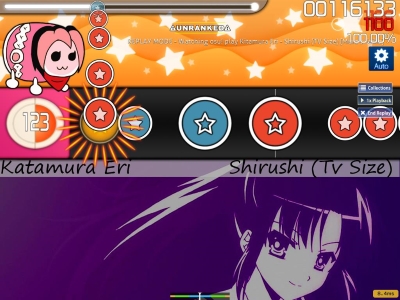 osu!taiko hit circles
osu!taiko hit circles
Taiko notes will appear as either a red or a blue circle. These circles are called Don (for red notes) and Katsu or Kat (for blue notes), respectively.
If it is a small red note, press the button bound to the inner portion of the taiko drum or hit the large flat area (centre) of the TaTaCon. If it is a small blue note, press the button bound to the outer ring of the taiko drum or hit the sides of the TaTaCon. If the note is a LARGE circle, press or hit both of either inner or outer drum depending on the colour of the note for double the points (a single correct hit will give single point instead).
The notes must be pressed or hit in the small white judgement circle next to the drum. Hitting the wrong colour, or both red and blue colours at the same time, will be considered a miss.
Drumrolls
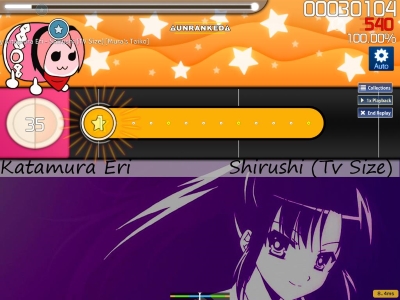 osu!taiko drumroll
osu!taiko drumroll
Hit the inner (or outer) parts of the drum continuously for points until the end of the drumroll. For LARGE notes, hit both buttons on the inner (or outer) drum simultaneously and continuously until it is complete. Do note that drumrolls hits are hardcapped and only counted when hitting on the tiny hit circles, rather than being able to drumroll as fast as possible as in Taiko no Tatsujin.
Drumrolls can be ignored with no health penalty, as they do not recover the health bar at all. However, it will cost possible points gained from the drumroll. Each successful hit on the tiny hit circle gives a static 300 score.
Dendens/Shaker
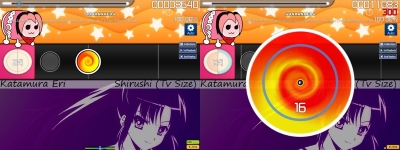 osu!taiko spinner (denden)
osu!taiko spinner (denden)
Hit the inner and outer drum in order (like red, blue, red, blue, red, blue, ...) until the denden counter reaches 0. The starting colour does not matter (you can start with blue or red), and failing to complete it will incur a miss health penalty but no combo break. Hitting the same colour will not decrement the denden counter, until a different colour is hit instead.
They do not increment the combo counter, and does not recover the health bar in any way. Each successful denden hit only gives a static 300 score, and denden completion will give a perfect (GREAT) large note score.
Play Styles
Refer to Play Styles page under osu!taiko.
Controls
The default controls for osu!taiko are:
| Type | Mouse | Keyboard | TaTaCon |
|---|---|---|---|
| Red | Left click(L) | X (L) / C (R) |
Flat surface of the drum |
| Blue | Right click(L) | Z (L) / V (R) |
Outer surface of the drum |
The placement of the in-game cursor does not matter when playing.
If the Relax mod is used, the score judgement only accounts for hit timing (the mod automatically adjusts hits to the correct colour).
The TaTaCon drum controller was primarily made for the home ports of Taiko no Tatsujin and Taiko: Drum Master, but is not as common in osu!taiko. However, the options menu has an option for Wiimote/TaTaCon Drum support.
Scoring
Score in osu!taiko is a weighted sum of multiple components of gameplay. It depends on the following:
- Judgement determines a hit object's base scoring value (300, 100, or 0 in case of a miss). The value of regular and large notes depends on hit timing, while every other object's base value is constant.
- Accuracy depends on judgement and shows how precise hits are. Late or early key presses, as well as misses, decrease overall accuracy.
- Kiai time: in osu!taiko, kiai time increases score gain by 20%, just as it does in the original Taiko no Tatsujin series.
In addition to giving score, each cleared object fills a small part of the health bar, which must be at least 50% full for a player to pass a beatmap.
After completing a beatmap, the score is assigned a grade, a short accuracy assessment in the form of a single letter. A golden or silver SS denotes 100% accuracy, and everything else, from S to D, depends on the amount of 300s, 100s, and misses.
Skinning
Refer to Skinning page of osu!taiko for full information.
osu!taiko Mapping
- Red notes refer to normal hit circles,
- large red notes need a finish hitsound.
- Blue notes need to have a whistle/clap hitsound on that hit circle,
- large blue notes need both finish and whistle/clap together.
- The sliders represent the long yellow note (also known as a drumroll)
- The spinner represents a denden.
Placement of the notes does not matter.
osu! conversion notes
When a map conversion happens (playing an osu! map in osu!taiko mode), very short sliders (usually less than a beat) are automatically converted to red or blue notes, depending on the hitsound used.
For maps with 125 BPM or lower, 1/8 drumrolls are given instead of 1/4 drumrolls.
Do note that 1/8 rhythms are not often used in music. It is not suggested to place sliders when in 1/8 rhythm.
Also note that 1/6 drumrolls are given if the slider tick rate of 3 was used.
Trivia
Gameplay
- Playing on an empty playfield does not incur any miss.
- Drumroll: The upper limit on number of hits on the slider is:
- 4 times of the length of slider, or
- 8 times of the length of the slider in songs that is equal or lower than 125 BPM.
- Unlike the other game modes, Kiai Time influences scores because it is based off of the "Go-Go Time" in Taiko no Tatsujin. While Kiai Time is active, the drum in the upper-left changes animation (named pippidon in osu!taiko or Don/Katsu in Taiko no Tatsujin), the playfield has a background gradient and the hit area gains a fire graphic around it.
- Additionally, all hit notes gain a 1.2x score multiplier, long yellow notes included, except for hits on a spinner (the final hit is still multiplied).
- When played by Auto, the player name will be mekkadosu!.
History
 Taiko logo in Special Mode
Taiko logo in Special Mode
- The
Use Taiko skin for Taiko modein Options sidebar under Skin section will use thetaikofolder's skin elements when playing in osu!taiko, regardless of the current skin's taiko elements. The folder used to hold the skin Taiko by LuiginHann, which could be downloaded from the now-deprecatedosume.exe(the original update system, before it was integrated into the game) underSkintab. - The first ranked beatmap to contain an osu!taiko difficulty was Taiko no Tatsujin - Saitama2000 by Kharl
- The first ranked osu!taiko-specific beatmap was Mutsuhiko Izumi - Red Goose by lepidopus